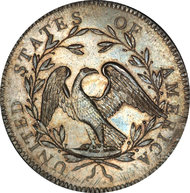
FLOYD NORRIS
Notions on high and low finance.
Who says a dollar doesn’t hold its value?
A 1794 silver dollar sold at auction last week for $10,016,875, according to Stack’s Bowers Galleries, an auction house.

It says that set a record for any coin, easily passing the 2002 record price of $7,590,020 for a 1933 double eagle, a $20 gold piece.
 Stack’s Bowers Galleries The 1794 silver dollar sold at auction for $10,016,875.
Stack’s Bowers Galleries The 1794 silver dollar sold at auction for $10,016,875.
It also reports that a 1792 “half disme” — worth five cents when issued — sold for $1,145,625, and a 1793 one-cent coin sold for $998,750.
The gain in price for that silver dollar amounts to a little more than 1 billion percent, but the half disme went up more than 2 billion percent and the penny climbed almost 10 billion percent. It makes the double eagle’s climb of almost 38 million percent sound puny.
But this is an example of the wonders of compound interest. The double eagle was only 69 years old when it was sold. That was a compound annual gain of 20.5 percent.
By contrast, the compound annual gains for the other coins — each more than 200 years old — are 7.6 percent for the dollar, 8.0 percent for the half-dime and 8.7 percent for the penny.
Article source: http://economix.blogs.nytimes.com/2013/01/29/inflation-rare-coin-variety/?partner=rss&emc=rss
Speak Your Mind
You must be logged in to post a comment.